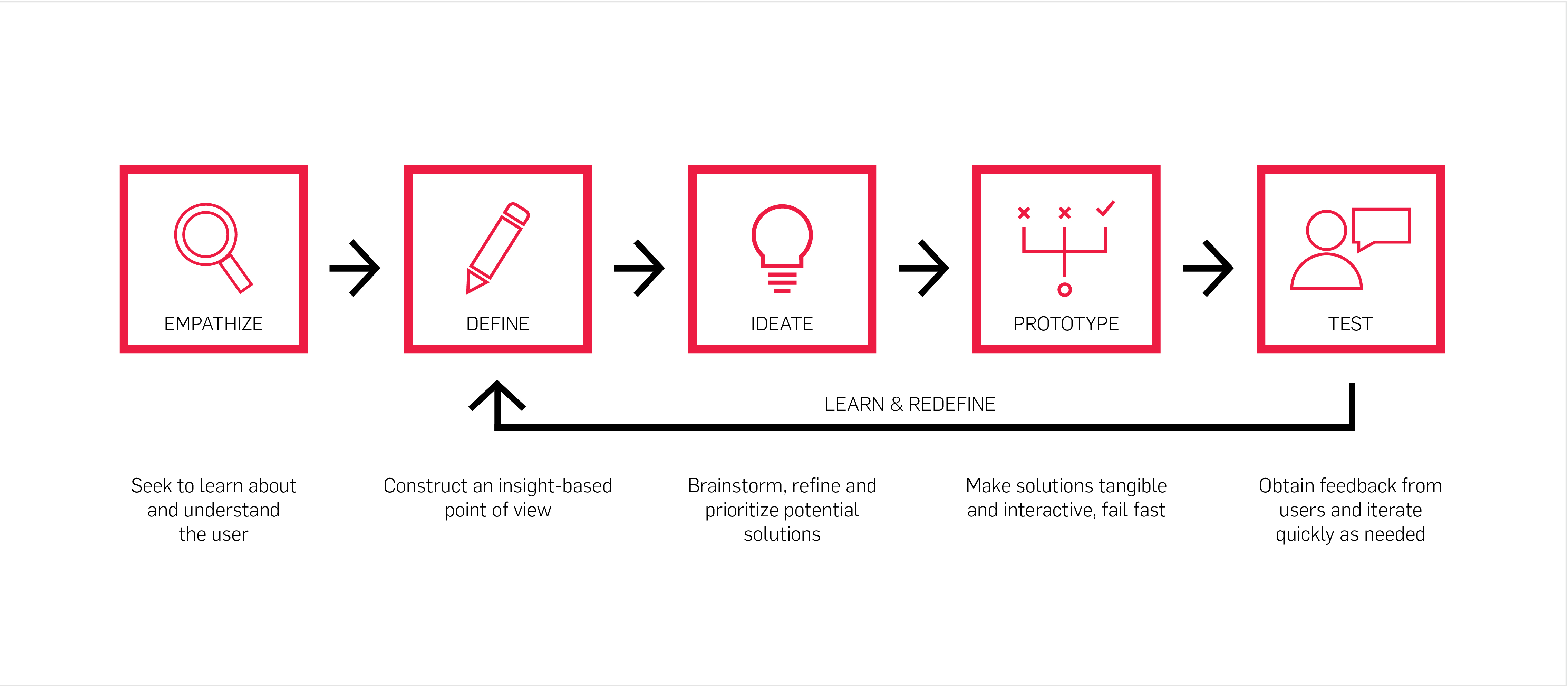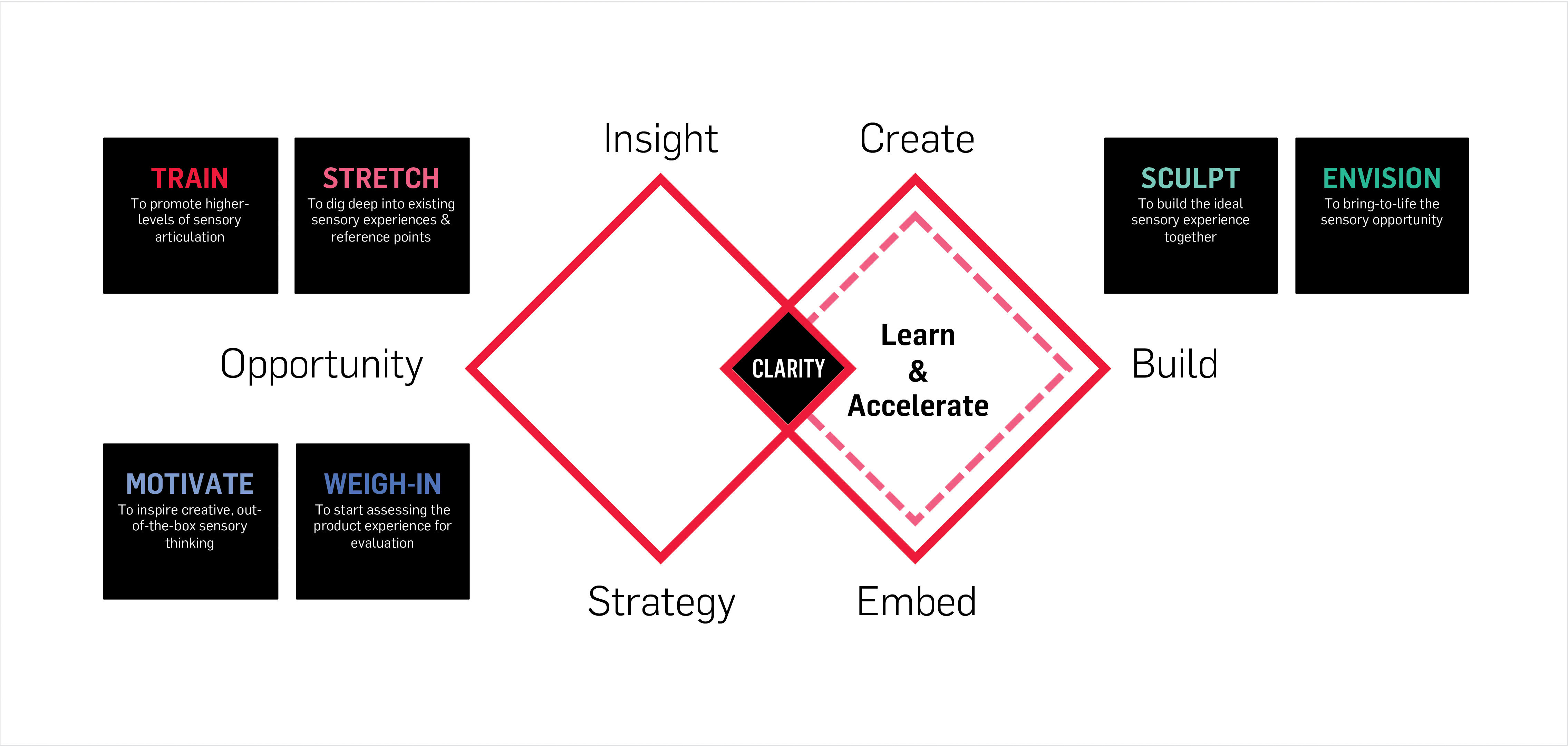Smarter, better, faster, stronger
Using Sensory Strategy to go beyond Design Thinking
It’s the fashion among big brands to use Design Thinking to get closer to the consumer earlier in the development process.
Why?
It helps bridge the gap between trial and repeat, and between Marketing and R&D. It turns fleeting flirtations into long term brand loyalty. And in a world where the new CEO of KraftHeinz is telling us that they need to get closer to the consumer, innovate faster and take advantage of premiumization, it’s no wonder that marketers and R&D professionals are looking to proven techniques to deliver ROI in more agile ways.

In a nutshell, Design Thinking differs from the traditional linear innovation process in that it brings the consumer closer in, using various tools to help empathize and understand their needs and define the problem to solve, ideating potential solutions and then developing prototypes to test with them. This gives project teams access to consumer feedback earlier on in the development process and helps them get to optimized solutions much faster, shortcutting any rabbit holes of development that aren’t worth pursuing.
But if everyone’s doing it, how can brands get even smarter, better, faster and stronger results?
Design Thinking is great for ideating specific product concepts and optimizing them. It’s not so great at building out new product opportunity spaces from the ground up, at more of a foundational level — that space after the technology or ingredient has been identified, but before potential concept routes have been defined.
The rise of Sensory Strategy
As R&D uncovers new technologies and ingredients, or even seeks to repurpose assets they are underutilizing, they need a better way to understand and explore the associated consumer needs and benefits before concepts are defined.
Evaluating concepts or developing product prototypes without a deeper understanding of consumers’ perceptions and needs is risky and wastes valuable resources, yet brands continue to do it, killing off prospective spark opportunities before their true potential can be realized. Remember, Nokia created and then killed a touchscreen phone several years before Apple launched the iPhone…
We often hear from senior R&D stakeholders that they want more foundational consumer insight earlier in the process in order to identify the range of possible areas where technologies and ingredients can play, and to uncover the product and packaging guardrails that exist within those opportunity spaces. And ultimately, understanding these needs and perceptions in consumers’ own words leads to better articulated concepts.
Connecting this up with prototyping creates much stronger product-to-concept fit. It provides the springboard for multiple concept iterations and minimizes the expectation gap — bringing marketing and R&D closer together. The result? Smarter, better, faster, stronger products that launch well – and deliver clear growth.
Consumers struggle to say what they want…
We know that consumers aren’t particularly good at expressing their needs or finding ways to best address them. Sensory Strategy takes a different approach by building a powerful, comprehensive understanding of perceptions and needs that goes beyond the traditional consumer empathy techniques utilized in Design Thinking. To stretch consumers and get to the heart of implicit attitudes and emotions, we designed a suite of techniques and enablers (aptly named the Sensory Gymnasium®) to help consumers articulate and co-create the optimal sensory experience.

The Sensory Gymnasium® gets under the hood of consumer thinking and behavior in 3 key ways:
1. Tapping into System 1 & System 2 thinking to identify what drives decision-making
Consumers rely on a combination of System 1 (quick, automatic, and intuitive) and System 2 (effortful, rational, and informed) thinking to make judgements and decisions about products. It’s difficult to deconstruct what exactly influenced their thinking at any given moment. By breaking a product down to the individual attribute level, such as the color of the product or shape of the packaging, we can elicit gut-level responses to unpack underlying System 1 and 2 perceptions and uncover the product and packaging cues that drive or detract from beliefs about a product’s claims or benefits.
System 1 and System 2 thinking each come with their own inherent biases. To account for these, we carefully consider and make strategic selections to ensure the right range and depiction of physical stimuli. Interactive exercises and projective techniques allow us to capture initial System 1 perceptions as well as explore more in-depth System 2 rationalizations.
2. Drawing out rich, descriptive language from target consumers, not sensory or creative experts
Where traditional sensory analyses draw on trained experts to identify specific nuances through sensory evaluation, the Sensory Gymnasium® empowers your target consumers to find their own language and terms to describe their motivations, functional and emotional needs, and sensory perceptions and associations.
This is where the Sensory Gymnasium® enablers really change the rules of conversation with consumers (and project teams), by providing new ways to communicate and listen back, engaging the senses and stimuli in new ways.
3. Illuminating the sensory guardrails that bring opportunity areas to life, providing a roadmap for better concepts and helping close the expectation gap
Identifying the range of permissible product and packaging elements allows us to create a strategic playbook demonstrating how to connect the dots between consumer motivations, compelling reasons to believe, and the ways to bring it to life, giving R&D teams the tools they need to craft solid product executions.
Leveraging the Sensory Gymnasium® across an insight-based, opportunity-led approach ultimately leads to a more robust strategy, a broader range of avenues for innovation and renovation, and more rigorous concept and product development.

Clear benefits
We’ve summarised the value of this approach in four clear benefits – which we’ve delivered for a number of brands in a variety of sectors:
1. Having a clear Sensory Strategy to work against unlocks brand potential, creates impactful experiences, and uncovers new growth opportunities.
2. It helps brands go faster and work smarter, by building more robust foundational learnings down to the product and package attribute level before the prototyping stage that the organization can leverage for other challenges, not just the one at hand.
3. Using consumer language helps brands learn how to communicate more effectively through packaging choices, graphics, advertising, media channels and even voice.
4. Connecting the dots between consumer-driven motivations, RTBs, and the product and packaging elements to deliver provides a roadmap to create a stronger product / concept fit.
Our work with Mondelez and other clients proves that Sensory strategy has the potential to help CPG brands take the next step beyond Design Thinking – and unlock greater competitive advantage, earlier than ever before.